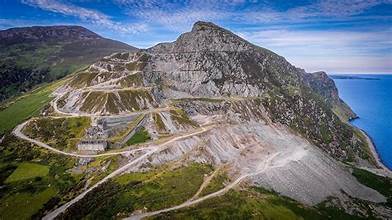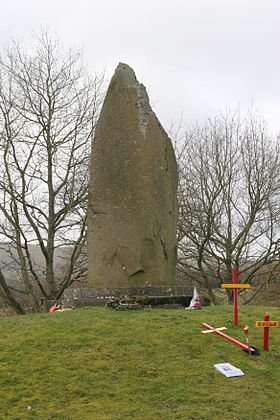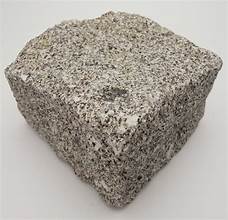The Eifl Quarry
There were three granite quarries on the west side of yr Eifl, and those were the main
employers of the quarrymen from Lithfaen and Nant Gwrtheyrn: Chwarel y Nant (Nant Quarry)
Chwarel Cae’r Nant (Cae'r Nant Quarry) and Chwarel Careg y Llam (Carreg y Llam Quarry).
 Eifl quarry from the North
Carreg y Llam (The Leaping Stone) is supposedly where Kking Vortigern leapt to his death after
realising what Hengist had done.
To the right, before the path you see the summit of Garnfor, anh here the quarrying is evident.
This is the top of Chwarel yr Eifl (yr Eifl Quarry) or Gwaith Mawr (Main Quarry) as it’s colloqually
known.
Eifl quarry from the North
Carreg y Llam (The Leaping Stone) is supposedly where Kking Vortigern leapt to his death after
realising what Hengist had done.
To the right, before the path you see the summit of Garnfor, anh here the quarrying is evident.
This is the top of Chwarel yr Eifl (yr Eifl Quarry) or Gwaith Mawr (Main Quarry) as it’s colloqually
known.
 Memorial stone of Llywelyn our Last Saviour, Kilmeri
Memorial stone of Llywelyn our Last Saviour, Kilmeri
The quarry produced sets to pave the streets of the cities. A setsan, or a ciwban (cube stone) measured 10cm by 10cm.
It’s hard to believe that a hundred and forty of these could be made in a day, the record of the skilled craftsman. There was a lot of migration between Penmaenmawr (another area that produced sets) and yr Eifl. The quarrymen also travelled to the north of England, Scotland and Cornwall in search of work.
Samuel Holland , one of the pioneers of the slate quarries of North Wales, discovered the granite at Chwarel y Gwylwyr (Gwylwyr Quarry) in Nefyn. He also found the same kind of stone here.
Setts were made in Gorllwyn in the earliest era (about 1836-40). The quarry opened under the name The Welsh Granite Company Limited in 1850. By 1865, horses were used to pull the wagons. By 1870, the pier was ready, and by 1873, a steam engine pulled the wagons to the pier. The village of Trefor was named after Trefor Jones, the then quarry manager due to the quarry’s resounding success.
As the rock here is of a particularly good quality for making sets and paving roads, and could
withstand heavy loads and transport, and is a rock that didn’t become slippery underfoot,
unlike setts from other parts of the country, the stones were in demand, and consequently the
 Set
quarry became larger, and workers flocked to Trefor. Gradually, a gallery was opened, then
another, and another after that, until there were a total of nine galleries in the quarry, reaching
to the top of the mountain, and each was about 100 to 120 feet high. In the early part of the
20th century about 600 worked at the quarry. By 1930, it had produced 1,157,000 tons of setts
and had become the largest granite quarry in the world.
After employment resumed following the Second World War, a crusher was built to grind the
stones into chippings, being prefered to setts by this time, with the introduction of tarmac.
Gravestones and memorials, rollers to make paper, and curling stones were being produced,
and by the lat 1960s, the quarry only employedabout 50 people, as machines did most of the
work.
Set
quarry became larger, and workers flocked to Trefor. Gradually, a gallery was opened, then
another, and another after that, until there were a total of nine galleries in the quarry, reaching
to the top of the mountain, and each was about 100 to 120 feet high. In the early part of the
20th century about 600 worked at the quarry. By 1930, it had produced 1,157,000 tons of setts
and had become the largest granite quarry in the world.
After employment resumed following the Second World War, a crusher was built to grind the
stones into chippings, being prefered to setts by this time, with the introduction of tarmac.
Gravestones and memorials, rollers to make paper, and curling stones were being produced,
and by the lat 1960s, the quarry only employedabout 50 people, as machines did most of the
work.
It was from here that they took for the memorial stones for Llywelyn af Gruffydd, ein Llyw Olaf (Our Last Ruler), Hen Ŵr Pencader (The Old Man of Pencader) and I.D.Hooson.